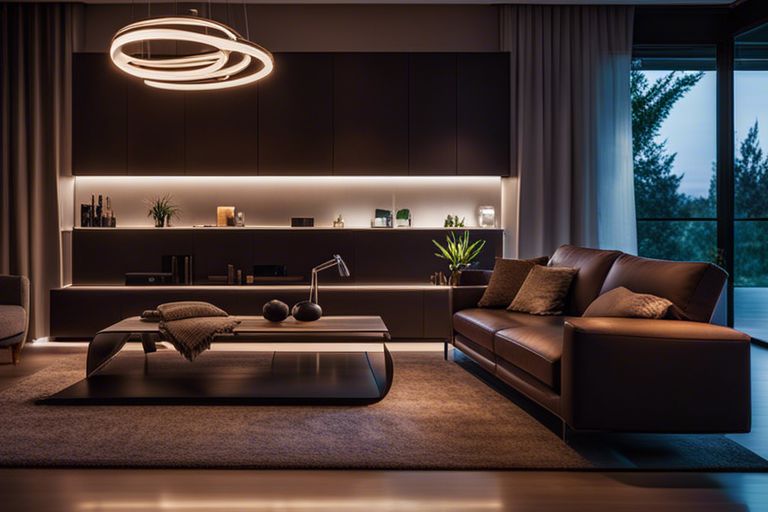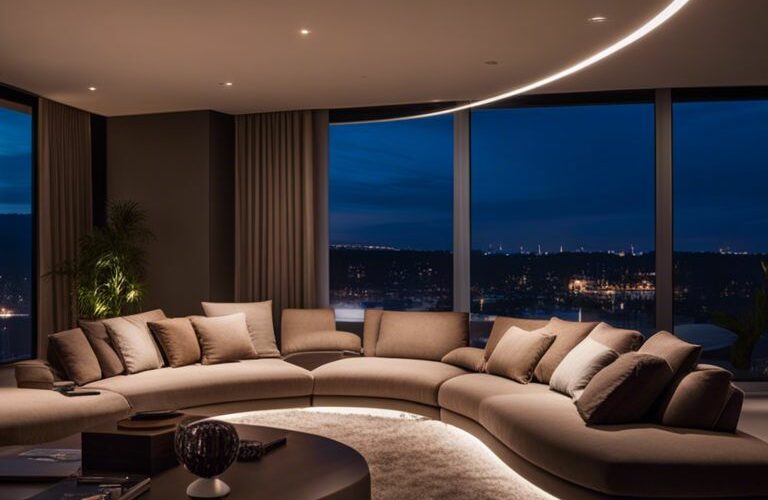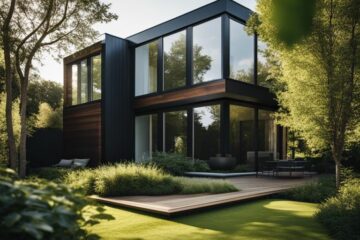Concerning illuminating your home, making eco-friendly choices is crucial for a sustainable future. LED lights have emerged as the top choice for environmentally conscious homeowners, and for good reason. LED lights are not only energy-efficient, but they also have a significantly longer lifespan compared to traditional incandescent bulbs. This means fewer replacements and less waste in the long run. Additionally, LED lights do not contain harmful substances like mercury, found in other types of bulbs, making them safer for both your family and the environment. By choosing LED lights for your home, you are not only reducing your carbon footprint but also saving money on energy bills in the process. Make the switch to LED lights today and illuminate your home in a sustainable and cost-effective manner.
Table of Contents
Understanding LED Technology
What Are LED Lights?
LED stands for Light Emitting Diode, and these revolutionary light sources have transformed the way we illuminate our homes. Unlike traditional incandescent or fluorescent bulbs, LED lights do not rely on filaments or gases to produce light. Instead, they operate by passing an electrical current through a semiconductor material, which in turn generates photons – the basic units of light. LED lights are not only energy-efficient but also environmentally friendly, making them an ideal choice for eco-conscious homeowners.
LED lights come in a variety of colours and intensities, allowing you to create the perfect ambience for any room in your home. Whether you prefer warm, soft lighting for your living room or bright, cool lighting for your kitchen, there is an LED bulb to suit your needs. Additionally, LED lights last significantly longer than traditional bulbs, reducing the frequency of replacements and ultimately saving you money in the long run.
The Science Behind LED Efficiency
LED efficiency can be attributed to their unique design and operation. Traditional bulbs waste a significant amount of energy as heat, whereas LED lights convert almost all of the electrical energy they consume into light, with very little heat loss. This energy-efficient process not only lowers electricity bills but also reduces the carbon footprint associated with lighting your home.
LED lights also do not contain any hazardous materials such as mercury, making them safer for both your family and the environment. This means that in addition to saving energy and money, choosing LED lights contributes to a cleaner, greener planet for future generations.
Environmental Benefits of LED Lighting
Energy Efficiency and Reduced Carbon Footprint
LED lights are highly energy-efficient compared to traditional incandescent and fluorescent lighting. They require much less power to emit the same amount of light, resulting in significant energy savings over time. This efficiency not only translates to lower electricity bills for homeowners but also plays a crucial role in reducing carbon emissions associated with electricity generation.
By switching to LED lighting, individuals can lower their carbon footprint and contribute to sustainability efforts. LED lights use up to 90% less energy than incandescent bulbs and have a longer lifespan, meaning fewer resources are consumed in manufacturing and transportation. This makes them an environmentally friendly choice for those looking to make a positive impact on the planet.
Longevity and Less Waste
LED lights have a remarkably long lifespan, lasting up to 25 times longer than traditional incandescent bulbs. This longevity not only reduces the frequency of replacements but also minimises the amount of waste generated from discarded bulbs. As a result, LED lighting helps in cutting down on landfill waste and the overall environmental impact associated with lighting disposal.
Furthermore, LED lights are durable and robust, making them resistant to shock, vibrations, and external impacts. This durability further extends their lifespan and ensures that fewer lights end up in landfills, contributing to a sustainable waste management strategy.
LED lights are not only energy-efficient and long-lasting but also contribute to reducing waste and lowering carbon emissions. Their environmental benefits make them the preferred choice for eco-conscious homeowners looking to make a positive impact on the planet.
Economic Advantages of LEDs for Homeowners
Cost Savings Over Time
One of the primary economic advantages of using LED lights in your home is the significant cost savings over time. While LED lights may have a higher upfront cost compared to traditional incandescent or fluorescent bulbs, they consume much less energy and have a much longer lifespan. This means that you will save money on your electricity bills in the long run and won’t need to replace your bulbs as frequently.
Moreover, LED lights are more durable and resistant to breakage compared to traditional bulbs, reducing the need for frequent replacements. This makes them a cost-effective choice for homeowners looking to minimise maintenance expenses over time.
Government Incentives and Rebates
Another compelling reason for homeowners to switch to LED lights is the availability of government incentives and rebates. Many governments around the world offer financial incentives to encourage the adoption of energy-efficient lighting solutions such as LED lights. These incentives can offset the initial cost of purchasing LED lights, making them a more affordable option for homeowners.
Furthermore, rebate programs are often available that provide homeowners with financial rewards for making the switch to energy-efficient lighting. By taking advantage of these government initiatives, homeowners can not only save money upfront on their lighting upgrades but also contribute to a greener environment by reducing their energy consumption.
Practical Considerations for Switching to LED
Selecting the Right LED Solutions for Your Home
Pertaining to selecting the right LED solutions for your home, it’s important to consider the colour temperature and brightness level that will best suit each room. Warm white LEDs are perfect for creating a cosy atmosphere in living rooms and bedrooms, while cool white LEDs are ideal for task lighting in spaces like kitchens and home offices. Additionally, look for ENERGY STAR certified LEDs to ensure energy efficiency and quality performance.
Furthermore, consider the wattage equivalent of the LED bulb compared to traditional incandescent bulbs. This will help you determine the right brightness level without consuming excess energy. By carefully assessing your lighting needs and preferences, you can optimise your home’s lighting with LED technology while saving on energy costs in the long run.
Installation and Maintenance Tips
Pertaining to installation and maintenance of LED lights, there are a few key tips to keep in mind. Firstly, make sure to choose the right fixtures that are compatible with LED bulbs. Some older fixtures may not be suitable for LEDs, so it’s important to check before making the switch. Additionally, always turn off the power before installing or replacing LED bulbs to avoid any electrical hazards.
Regular cleaning of LED fixtures is also important to maintain optimal performance. Dust and debris can diminish the light quality and efficiency of the bulbs over time. Ensure that you clean the fixtures gently with a soft, dry cloth to avoid damaging the LEDs. Assume that proper maintenance will prolong the lifespan of your LED lights and keep them shining brightly for years to come.

Beyond Illumination: LEDs and Smart Home Integration
Compatibility with Smart Home Technology
In this modern age of technology, LED lights are not just about providing illumination; they are also capable of seamlessly integrating with smart home systems. LED lights can be easily controlled and automated using smart home devices such as smart speakers, smart light switches, or even mobile apps. This level of compatibility allows users to customise their lighting preferences, set schedules, and even change the colour of the lights to create the perfect ambiance.
Furthermore, the energy efficiency of LED bulbs makes them an ideal choice for smart home integration. With the ability to dim or turn off lights when not in use, LEDs can help reduce energy consumption and lower electricity bills. This eco-friendly feature, combined with smart home technology, offers a convenient and sustainable lighting solution for modern homes.
Enhancing Home Aesthetics with LED Lighting
LED lighting is not just about functionality; it also has the power to enhance the aesthetics of a home. The versatility of LED lights allows for a wide range of creative lighting designs that can dramatically transform the look and feel of any space. Whether it’s accent lighting to highlight architectural features or colour-changing lights to create a mood-enhancing atmosphere, LEDs offer endless possibilities for home decoration.
By strategically placing LED fixtures in different areas of the home, homeowners can achieve a stylish and modern look that not only improves the overall aesthetic appeal but also increases the value of the property. The long lifespan and durability of LEDs ensure that these lighting solutions remain cost-effective and visually appealing for years to come.
It is important to carefully consider the placement and type of LED lights to maximise the aesthetic impact while complementing the existing decor of the home. Additionally, exploring different light temperatures and colours can further enhance the mood of each room, creating a unique and inviting living environment.
Eco-friendly Illumination – Why LED Lights Are The Best Choice For Your Home
LED lights are undoubtedly the best choice for illuminating your home due to their eco-friendly nature. With lower energy consumption, longer lifespan, and recyclability, they are much more sustainable compared to traditional incandescent or fluorescent bulbs. LED lights not only help in reducing carbon footprint but also save you money in the long run through energy efficiency. By making the switch to LED lights in your home, you are not only contributing to a greener environment but also creating a brighter and more cost-effective living space for yourself. It’s time to make the sustainable choice and illuminate your home with LED lights.
FAQ
Q: What is eco-friendly illumination?
A: Eco-friendly illumination refers to lighting options that are energy-efficient and environmentally sustainable, such as LED lights.
Q: Why are LED lights considered the best choice for your home?
A: LED lights are the best choice for your home because they consume less energy, have a longer lifespan, produce less heat, and are free from harmful substances like mercury.
Q: How do LED lights help in reducing energy consumption?
A: LED lights are highly energy-efficient as they convert most of the electricity they use into light, rather than heat, making them consume less energy compared to traditional lighting options.
Q: Are LED lights cost-effective in the long run?
A: Yes, LED lights may have a higher initial cost than traditional bulbs, but they are cost-effective in the long run due to their energy efficiency, longer lifespan, and lower maintenance costs.
Q: What are the environmental benefits of using LED lights?
A: LED lights have minimal impact on the environment as they are free from toxic substances, emit less carbon dioxide, and can be recycled, making them a sustainable lighting choice for your home.

Our contributing author is a passionate advocate for eco-friendly living and sustainability. With a background in eco-life, they are dedicated to inspiring and empowering individuals to adopt environmentally conscious lifestyles. Through insightful articles, they share practical tips, innovative solutions, and thought-provoking perspectives to promote a greener, more sustainable world. Join them on the journey towards eco-smart living and discover how small choices can make a big impact. 🌱









